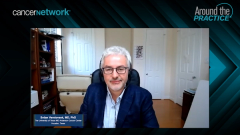
Assessing Response to Treatment in Myelofibrosis
Dr Srdan Verstovsek shares how he assesses myelofibrosis treatment response in his clinical practice.
Episodes in this series

John Mascarenhas, MD: Srdan, when you start someone on a JAK inhibitor, how do you assess response in standard-of-care clinical practice outside of a clinical trial? How do you gauge whether you’re satisfied with that response as the treating physician?
Srdan Verstovsek, MD, PhD: In the clinical studies, to give a perspective of what the studies called for, we’d measure the volume of the spleen with an MRI or CT scan and use a questionnaire to objectivize the symptoms. Then for anemia improvements, we’d look at the numbers or at the elimination of the transfusion dependency. That isn’t for spleen volume and constitutional symptom assessment. These tools are by and large not available to many of us. We wouldn’t do the MRIs or CT scans every 3 months to look for spleen volume reduction.
For reduction, we’d do a physical exam with a tape [measure] to see the size of the spleen from the midclavicular line on the left side to the most distant point of the spleen and try to have a semiprecise way of saying how much the spleen has shrunk. Ultrasound comes in handy occasionally, but it isn’t our standard practice. I’ve seen it used. However, through practice, you’ll perfect your way of palpation and using a tape. With some expertise in measuring like that, we’re pretty satisfied with that way of looking at it.
Constitutional symptoms are the key improvement that the patient asks for. They want to have a smaller spleen. It doesn’t matter whether it’s a quarter or 60% gone. They wouldn’t know unless you tell them. It’s smaller—that’s all that matters. But they want to feel much better. If you don’t have a questionnaire, through just a simple discussion with the patients, we understand the degree of constitutional symptom control. Try to write down the description of what has happened with the patients. Ideally, this isn’t that hard, one should use the MPN-10 [myeloproliferative neoplasm symptom assessment] questionnaire that the NCCN [National Comprehensive Cancer Network] guidelines strongly suggest to use to objectivize that, and put it in an electronic form so that patients can fill it out while waiting for you to see them, or the nurse can help them fill it out while you’re getting ready to see them. That’s a simple way in the community setting that may have real value in assessing what’s happening in terms of overall benefit of these different JAK inhibitors.
In terms of the other benefits, you’d look at the weight—weight is easy to measure—and performance status. This is normal for us to assess. With that, you’d get complete evaluation of the benefit. In terms of following the patients throughout the journey, I already mentioned the ultrasound that some doctors use as a measure every 3 or 6 months to assess the spleen response, and that MPN-10 questionnaire. Beyond this, it appears to be a relatively old-fashioned and simple approach. We don’t engage in much of anything else. It works. As I’d tell you from my experience, if you’re consistent and focused, it fulfills the purpose.
John Mascarenhas, MD: Excellent. Aaron, the NCCN Guidelines use the word monitoring. You monitor patients for any cancer therapeutic. But in the case of myelofibrosis and a JAK inhibitor, what does monitoring mean? How do you specifically monitor patients in terms of efficacy and toxicity, particularly the management of cytopenias?
Aaron Gerds, MD: Monitoring is purposely vague in the guidelines because you want to take it on a case-by-case basis. At a minimum, when a patient in my clinic is on an agent like ruxolitinib, fedratinib, or pacritinib, even if they’re doing fine and there’s absolutely nothing going on, myself or one of my colleagues in the clinic see them at least every 3 months to keep close tabs on things. By monitoring symptoms, you can definitely see slippage over time, so getting extra data points and measuring the spleen can be very helpful. It may go from 3 to 5 cm and then all of a sudden to 8 cm, and then you can look back and see what the trend has been doing and try to relate that to other features that you see.
In addition, you want to monitor other things that could be of consequence. The big thing is cytopenias. If I have a patient who’s teetering on anemia, where I think they may need an intervention, if they were to go on a JAK inhibitor, I’d probably measure their counts a little more closely, checking them at least every month or even more often to see if there’s a significant change. There are other things that you want to monitor going forward for these particular agents. Ruxolitinib can increase the cholesterol and triglyceride levels in patients, probably due to an effect on leptin, so keeping an eye on that is important. For fedratinib, there’s clear guidance in the package insert on monitoring thiamine levels. In addition to maybe giving thiamine supplementation, which a lot of folks do, you also check the levels. With pacritinib, there’s guidance in the package insert on checking for prolonged QTc [corrected QT interval], so getting EKGs [electrocardiograms] on these folks can sometimes be helpful as well to monitor that.
Like Srdan mentioned, I typically use the good old-fashioned fingertip and tape measure method of monitoring spleens on patients who aren’t on clinical trials. I get the MPN-10 as well on everyone to monitor their symptoms. Lastly, I use the good old-fashioned Patient Global Impression of Change. John, I know you’re a huge fan of that. “Are you better, worse, or the same since we started doing that?” That’s important too, along with documenting it so you can look back and see whether there are subtle things that have been happening over the last several months that indicate a slippage in efficacy where you may want to change what you’re doing. That way, you can marry what you’re seeing in the clinic with what was seen in the clinical trials and try to apply that going forward and head things off before they’re too bad, whether it’s cytopenias or worsening of symptoms or spleen size. Because the further it goes, the harder it ends up being to reverse that course.
Transcript edited for clarity.
Newsletter
Stay up to date on recent advances in the multidisciplinary approach to cancer.






















































































